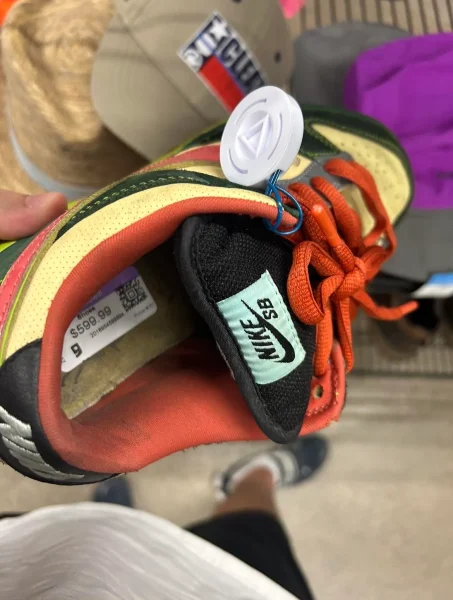Once stigmatized for being a resource for low-income families to acquire affordable clothing, thrifting has become a trendy and eco-friendly hobby. The activity has never been so mainstream due to the rise of social media platforms such as Instagram, TikTok, and Depop. This, along with a common desire to save money among members of Gen-Z— with 30% of Gen-Z reporting saving cash as the primary reason they thrift—the value of the global second-hand market is projected to reach $77 billion by 2025, and it’s only growing (1).
Recent changes noticed in thrift stores by frequent shoppers, sparking concerns about whether the recent popularity of thrifting is gentrifying the practice. Prices at thrift stores have risen due to multiple factors, making it hard to identify a single source to blame. On one hand, higher demand means more resources such as staff and infrastructure are needed to process and organize donations, driving up costs for businesses to operate. However, some thrift stores have capitalized on the trendiness of thrifting to raise prices solely for profit. This has created challenges for lower-income individuals, who rely on thrifting as an affordable way to purchase apparel rather than fashion. But is this greedy decision incentivized by thrifting’s newfound popularity that surprising?
The history of thrift stores is deeply connected with charity and capitalism, qualities that are still reflected in today’s thrift stores. In the late 19th century, Jewish immigrants in America, often excluded from other industries, started spearheading the resale of secondhand goods and going door to door with carts to sell used items. Despite the stigma they faced for appealing to low-income individuals, their success caught the attention of Christian missionaries, who saw an opportunity to combine secondhand reselling with charity. Organizations like The Salvation Army and Goodwill emerged, employing low-income individuals to collect and refurbish second-hand items while using profits to fund charitable programs. This origin is the primary reason thrift stores are associated with charity.
However, the growth of these charitable companies led to unprecedented greed. Chains, like Goodwill, expanded to be worth billions, allowing concerning practices to go overlooked. Cases of executives earning six-figure salaries while employees struggle with low wages have been documented (2). Additionally, scholarship programs intended for low-income individuals have been redirected to benefit children of VPs, highlighting the creeping influence of corporate greed (3). Moreover, for-profit chains like Savers have distorted the line between charity and commerce. By partnering with charities for marketing purposes, these companies front as a charity while funneling most of their profits into their business (4). These practices raise doubts about whether thrift stores truly redirect earnings to those in need.
On top of these concerning business practices, thrift stores raised prices due to rising demand and the emergence of resellers. Resellers, who purchase multiple items from thrift stores to sell them at a profit online, indicate to stores that wealthier customers are coming in and willing to pay significantly more for certain brands and unique finds. Thrift stores have caught on and noticed that they can safely increase prices without losing demand if they market toward wealthier customers. Additionally, as mentioned before, the growing popularity of secondhand shopping, especially with the youth, expanded the customer base. Because of this surge in interest, both nonprofit and for-profit stores are using the opportunity to raise costs and maximize revenue. Non-profits justify these price hikes as a means to fund charity, while for-profits don’t need to state a reason, as they aren’t required to serve lower-income members of their community or fund charity. These factors incentivize thrift stores to drive prices up, making thrifting less accessible to those who once relied on it for affordability.

Thrift stores’ rising prices has sparked online annoyance, with communities like r/ThriftGrift on Reddit documenting and criticizing “thriftflation”, where items are sold at inflated prices, sometimes exceeding their original retail value. These groups showcase the recent trend of thrift stores dramatically increasing prices, including charity thrift stores such as Goodwill and The Salvation Army.

Thrift stores are distancing themselves from their responsibility to support low-income households by marking up prices, despite having negligible supply constraints. While the rise in thrifting’s popularity has brought in more customers, it hasn’t significantly impacted their inventory. It’s estimated thrift stores typically sell only about one-fifth of their supply (5). This means the recent increase in demand doesn’t exhaust their stock. Instead, many stores are raising prices simply because they can, aiming to cater to a wealthier, trend-driven audience. By doing so, they prioritize profit over providing cheap apparel, making it harder for low-income families to access the once-affordable clothing they need. This highlights a concerning departure from thrifting’s charitable origins and a resource for those who needed it in the first place.
Sources:
https://cf-assets-tup.thredup.com/resale_report/2023/thredUP_2023_Resale_Report_FINAL.pdf
https://www.huffpost.com/entry/the-worst-corporation-in_b_1876905
https://wlos.com/news/news-13-investigates/where-does-the-money-raised-from-goodwill-go








